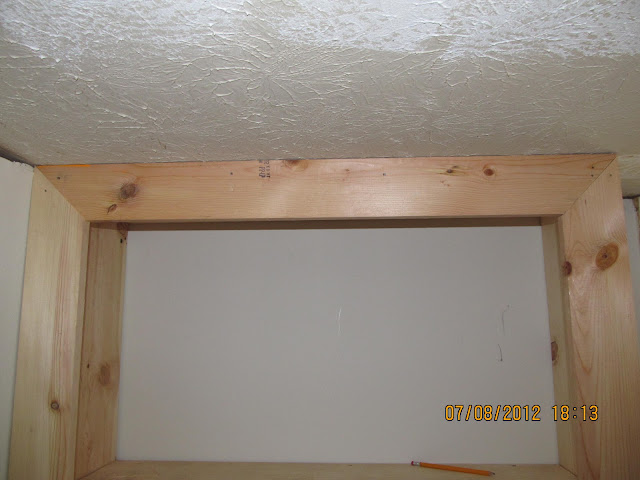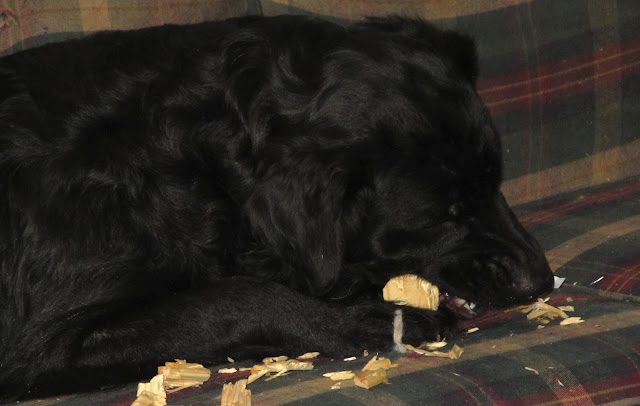 |
| The mostly finished window seat and book cases. |
 |
| This piano is probably the oldest thing that I own. |
 |
| One thing that breaks my heart about this house is that the old, original parquet floor in the foyer only comes part of the way into the living room. Oh, to have parquet throughout the house! |
I used oil-based stain because it has a longer working time than water-based. With pine, you never can tell how stain will absorb, so I wanted something that I could work into the wood really well. I chose antique walnut, which is the same stain that I used on the foyer doors. It also complements the piano and china cabinet. Wearing rubber gloves is a must when working with stain, especially if you're covering a lot of ground.
 |
| Find an old rag that you don't mind sacrificing, and rub the stain into the wood really well. When you wipe off the excess, work in the same direction as the wood grain to avoid dark streaks. |
 |
| Smaller cabinet door for under the window seat. |
The trim around the cabinet doors doesn't match the plywood perfectly because they're different species with different levels of porosity and wood grain. Once I wiped on polyurethane after the stain was set, the colors turned richer and the differences became less noticeable. Although we hadn't painted the room yet, I taped off the walls around the cabinets to protect them from stain.
| Although I knew better, I used masking tape to tape off the cabinet. It peeled off some of the paint primer on the walls. If you try this at home, do yourself a favor and use painter's tape. |
After staining, I installed the cabinet hardware. Prefab cabinets come with pre-drilled holes for hardware. When you build your own, you have to figure out where the hardware goes.
First, I measured the distance between bolt openings on the door handles. They're usually somewhat standard, but measuring helps avoid major screw ups. I marked the edge of the cabinet door to show where the handle should fit.
First, I measured the distance between bolt openings on the door handles. They're usually somewhat standard, but measuring helps avoid major screw ups. I marked the edge of the cabinet door to show where the handle should fit.
 |
| Sometimes it's easier to measure from the 1-inch mark than from the end of the tape. |
 |
| Tiny silver marks on the door from a washable marker help with alignment. |
 |
| Finding the width of the trim helps you find the center where the handles should fit. |
Speed Squares are such amazing little tools. So simple, but they help you keep everything straight.
 |
| Speed Squares have a perfect 90-degree angle, which keeps things straight as long as the edge of the board is also straight. |
 |
| To the extent possible, keep the drill bit horizontal to the plane of the cabinet door. If the bolt holes are tilted, the bolts won't align with the door handles. |
 |
| Slip the bolts through the back side of the door and into the handles, and tighten them until the handle fits snug against the door. |
After installing the hardware, there was one more thing left to do. I deliberately left the back wall of the book shelves bare because I wanted to decoupage pages from old books.
I cut out certain paged and pasted them on the wall with thinned wood glue and a sponge paintbrush. It's like going back to kindergarten craft time, except that nobody tells you not to eat the paste (Don't eat the paste!). The only rules that I discovered are that thinning the glue with water makes it easier to spread, but thinning it too much can warp the pages.
This is my Edgar Allan Poe section when I'd just started the job.
I cut out certain paged and pasted them on the wall with thinned wood glue and a sponge paintbrush. It's like going back to kindergarten craft time, except that nobody tells you not to eat the paste (Don't eat the paste!). The only rules that I discovered are that thinning the glue with water makes it easier to spread, but thinning it too much can warp the pages.
This is my Edgar Allan Poe section when I'd just started the job.
 |
| Lime green flip flops aren't mandatory. |
We ran out of time because company was arriving, so I had to put the remainder of decoupaging on pause. I do that a lot, putting off projects.
A bit of advice for decoupaging. Cover the surface with pages that aren't special before layering on the pages that you want to see. That way, you won't have to cut and trim and cuss to make the pages fit the way you want them to. I trimmed and cussed a bit.
Besides finishing the back walls, there are two more things that have to be done. I still need to finish sewing the bench cushion cover, and I want to install a plant shelf between the two book cases. Mr. V. and I found two of these brackets at a little antique shop, and they will fit under the left and right ends of the shelf.
 |
| $20 for a pair of these. Not too shabby. |
It will look a little something like this, except that I'll fasten them to the cabinets so that Mr. V. doesn't have to hold them forever.
 |
| He isn't crazy about modeling for me. |
All in all, I would call this project an official success. The bench seat is so sturdy that I can walk on it without any bends or creaks, and the cabinets are so sound that I think that's where I'll hide next tornado season.
Building a custom cabinet takes a lot of planning, flexibility and compromise, especially in an old house where nothing is square. But that's also part of the fun. You can customize it any way that you like. As long as the structure is sound, anything goes.
Building a custom cabinet takes a lot of planning, flexibility and compromise, especially in an old house where nothing is square. But that's also part of the fun. You can customize it any way that you like. As long as the structure is sound, anything goes.
XOXO





























